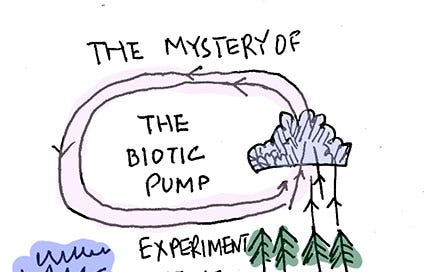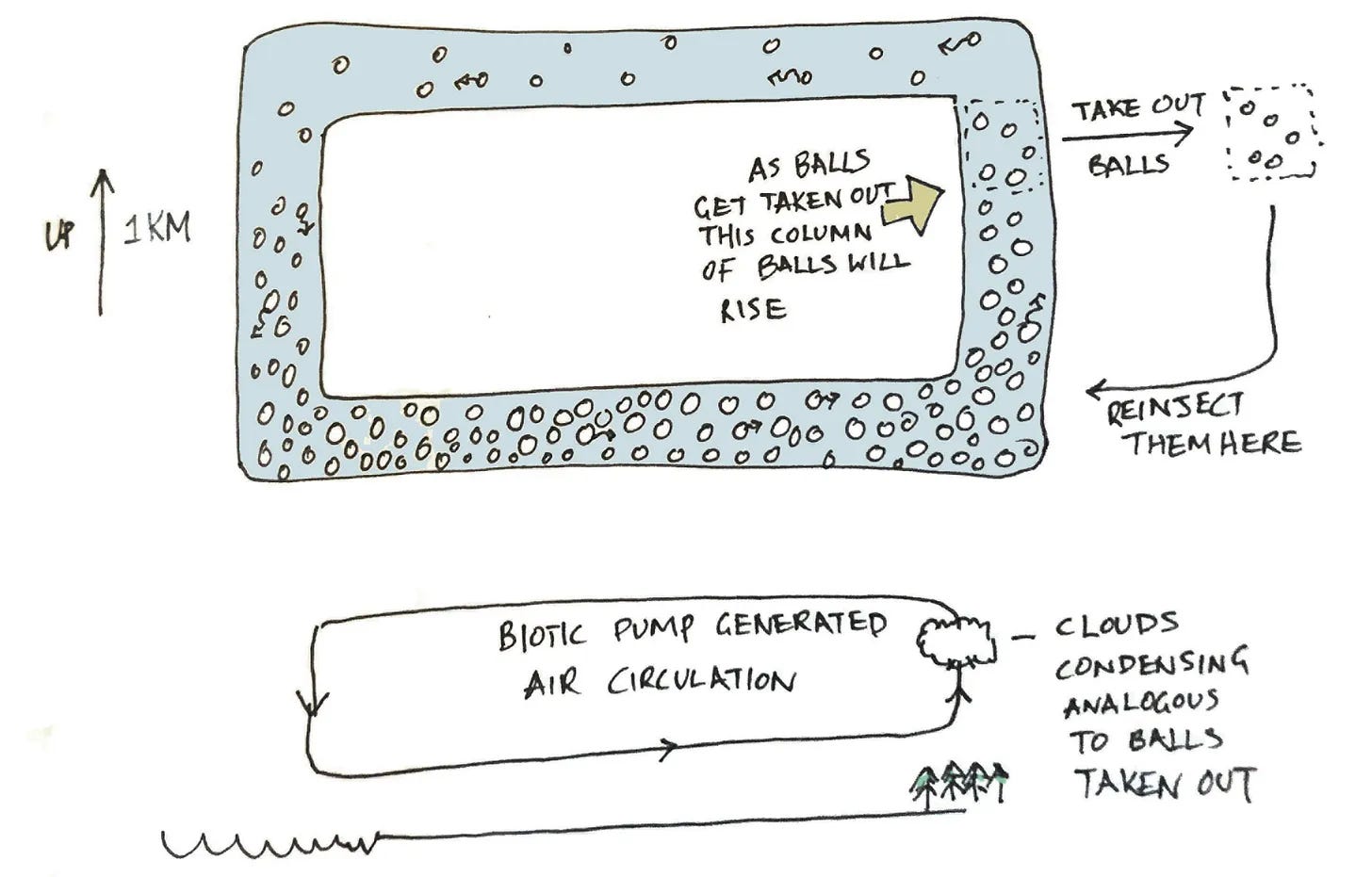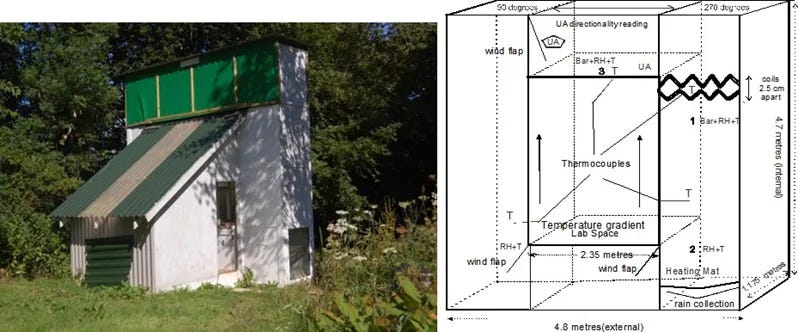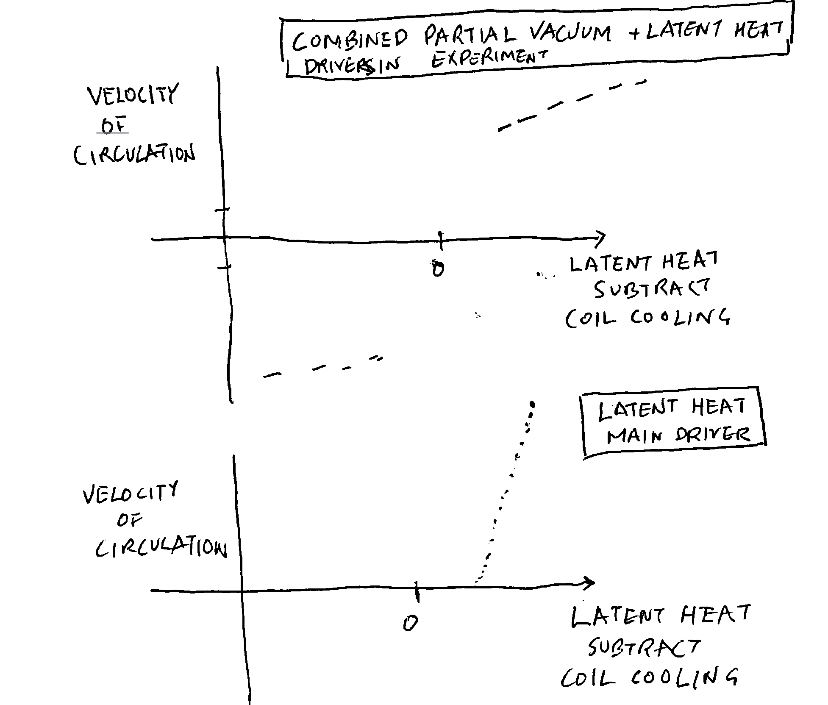The mystery of the biotic pump experiment that rotated the wrong way
broken symmetries, kick-starts, and condensation implosions, and why Bunyard’s expeperiment is a step towards proving the biotic pump
Peter Bunyard had become very intrigued with the biotic pump, and thought maybe he could prove it experimentally. He was the founder of The Ecologist magazine, and had a science background, having studied natural sciences at Harvard and Cambridge. So he built a flow chamber where he could condense water vapor and see if would induce circulation in the chamber, simulating an aspect of the biotic pump. And lo and behold he did get circulation. He thought he had settled two biggest objections scientists had to Makarieva and Gorschkov’s biotic pump theory (which was about how forests can call the rain by creating winds from the ocean) - i) that the heat released via water vapor condensing was more important than the vacuum generated by the water vapor condensing, and ii) that the condensation implosion of the biotic pump was a process in all directions and would not lead to circulation in one direction, like what happens over forests. He sent a paper on his experiment in for publication. But the reviewers looked at the paper, and said the air was circulating the wrong way. When a forest transpires and the water vapor condenses, the air moves up. In Bunyard’s experiment when the water vapor condensed, the air moved down. Because the air circulation rotated the wrong way, the paper was denied publication.
I will argue in this essay how the biotic pump could still be true even though the air circulation went the wrong way, and that Bunyard’s experiment is an important step towards proving the biotic pump. I then make a suggestion on a variation of Bunyard’s experiment to do next to verify the biotic pump hypothesis.
……….
Over the winter break I was revisiting the biotic pump topic. A year and a half ago I interviewed Anastasia Makarieva about the biotic pump. It a theory about how forests attract the rain. Forests transpire a large amount of water vapor. That water vapor then condenses, leaving a partial vacuum (other gases are still present) where it once was. The water vapor takes up 2000 times the room liquid water does. Imagine the water part of the gas shrinking to 1/2000 th its size. When water vapor is cooled to condensation in a steel drum, the resulting partial vacuum can cause the drum to implode violently - a very powerful force. The partial vacuum, which leads to a pressure drop, is postulated in the biotic pump theory to be strong enough to suck in wind from the ocean. That wind contains ocean moisture. A large scale circulation is induced. Transpiration from the forest adds to the ocean moisture in the wind to create rain for the forest.
I came up with a number of toy models when I was writing the Makarieva essay, to try and understand the biotic pump idea better. Heres a picture of one of them. You can go to the appendix, for more information on my toy models.
I thought then to ask my colleague Ali Bin Shahid, if he might be able to calculate from these toy models something that might prove the biotic pump. He had also, at that time, coincidentally, been writing an essay about the biotic pump.
He brought up that Peter Bunyard had been doing an experiment, that had some similarities to my toy model. Here is a picture of his experiment from Bunyard’s paper.
Bunyard built this rectangular loop, and filled it with humid air. Cooling coils (the zigzaggy lines in diagram above) were put in. When the coils cooled the air, there was indeed circulation. In the diagram below you can see what happened when he switched the cooling on and off for five times. Each time the airflow velocity jumps.
When Makarieva and Gorshkov published their original paper on the biotic pump, there were a number of criticisms from reviewers. Axel Kleidon was one of the reviewers. He had published work showing the vegetated continents have more rain than deserted continents, and also was one of the few climate scientists still working on Gaia ideas, and so had certain philosophical stances that were similar to Makarieva and Gorshkov. He did a calculation, and found that the latent heat released when the water vapor condenses (water vapor stores energy which it ‘lets go’ of when it turns into liquid), was greater than the energy from the partial vacuum effect (when water condenses it creates partial vacuum that sucks in air). To him, therefore, the heat released was driving the air circulation, not the partial vacuum as postulated by the biotic pump theory. Other reviewers agreed.
Gorshkov and Makarieva reply was that, yes, the latent heat effect was stronger than partial vacuum effect locally, but that if you look at the whole atmospheric circulation loop then the partial vacuum effects become more important, because when the air is heated up, it is then harder to come down. This means that while, on the upward leg of the latent heat effect works to speed up circulation, on the downward leg, the latent heat effect works to slows circulation.
What Bunyard did in his experiment, was find an intriguing attempt to take out the latent heat effect, and address the reviewers who thought that partial vacuum on its own would not do the trick to create large scale atmospheric circulation. By cooling the air, he was removing the latent heat added. He found that there was still circulation, which implied that the partial vacuum was key in creating atmospheric circulation.
Bunyard also tried to address the other complaint that reviewers made of Makarieva and Gorshkov’s biotic pump paper which was that the partial vacuum effect should cause an implosion that was isotropic. It should flow in from all directions the same way. If so, then how could it cause atmospheric circulation that went a particular direction, they asked.
Bunyard wrote about how his experiment addressed these reviewers concerns, “the widely-accepted assumption is that the movement of air in condensation of water vapour is invariably an isotropic process, with the air moving from all directions simultaneously, preventing any net, uni-directional flow. The experimental results indicate instead that condensation can be anisotropic, and can lead to net airflow… In all experiments, once refrigeration was switched on, airflow became apparent within 30 seconds.”
Amidst our discussions, Ali studied the numbers. Latent heat release occurs at the rate of 2.25 kJ/g, while condensation implosions occur at the rate of 0.17 kJ/g. So latent heat effect was an order of magnitude bigger (as Kleidon had noted). Ali wrote, however, “even though latent heat is 15 times stronger on paper, its energy disperses over larger areas. In contrast, condensation applies energy locally, rapidly accelerating air movement.”
The partial pressure drop from the water vapor condensing was .7 watts. Using the basic kinematic equation of energy = 1/2 mass times velocity squared, Ali then got that the velocity was .24 m/s. Which is the velocity that the experiment measured.
So this was very interesting - the numbers were pointing to the partial vacuum effect being responsible for the air circulation.
I then noticed something strange in Bunyard’s results. The air circulation was moving the wrong way in the experiment. The air started moving down when the water vapor condensed. Circulation spun clockwise, instead of anti-clockwise. In a forest, the water vapor condensing leads to the air moving upwards, and then circulating anti-clockwise.
It turns out I was not the only one who had noticed. Axel Kleidon, it turns out, was also reviewing Bunyard’s paper. He wrote in the comment response to the paper “This manuscript describes an experiment in which the authors attempt to provide evidence for the biotic pump hypothesis of Marakieva et al. In this hypothesis, Marakieva et al. argue that the atmospheric circulation is mostly driven by water vapor pressure differences caused by condensation, which is in contrast to well-established concepts in atmospheric science. In principle, I think the authors’ attempt is creative and interesting and I feel sorry for my negative review.” He noticed that the air was flowing wrong way. He wrote "the direction of the observed air flow in the experiment likely contradicts the Biotic Pump hypothesis”.
Then he writes this banger of a line at the end “ To provide at least a little bit of a positive perspective at the end, I can imagine that this manuscript could become publishable by drastically changing its focus and make it a case study to disprove the Biotic Pump hypothesis”. He thought the wrong rotational direction actually disproved the Biotic pump.
At first, I thought he was being snide. But actually after rereading it and getting more context, I think he was being sincere and trying to be helpful. Science progresses by invalidating theories. Experiments that invalidate, are just as useful as experiments that validate them. So in his eyes Bunyard had done something useful by showing the biotic pump theory was wrong.
But the fact that the experiment goes the wrong way is actually a useful step to prove the biotic pump. That is because we know the latent heat is not important in the clockwise circulation as it would make it go anti-clockwise. What we now have to show is that this experiment can go anti-clockwise if we vary some parameters while keeping the partial vacuum effect.
I had a reason though for why Bunyard’s experiment could have air circulation under different circumstances gi different ways. . It had to do with something I had been thinking about over the winter break in regards to Makarieva and Gorshkov’s theory. It had to do with broken symmetry, an idea in physics which had snuck into a starring role in condensed matter physics and high energy physics.
To explain broken symmetry lets imagine a world where we are first laying down roads. At this point, we could choose to have cars drive down either side of the road. Before we make this choice the options are symmetrical. But once once local area decides to drive down on the left or the right, every other place has do the same thing. Once either left or right is chosen, the symmetry is broken.
Another broken symmetry example is the example of a pencil. If a pencil is standing on its end, its a radially symmetric position. Its also an unstable position, so the pencil will fall down. When it falls down in a certain direction it will break the radial symmetry.
If you heat a pan with water, at first it more uniformly heats up, which is a symmetric situation. But at some point if the heating increases enough, there will be convection. When that happens symmetry is broken. That’s because there are some places the water goes up and others it goes down. The water is no longer symmetric.
In the broken symmetry if you can nudge the situation one way, it will break the symmetry in that direction. So if you nudge the upright pencil one way it will fall in that direction. If there is some asymmetry in the pan, with one area on the bottom being slightly hotter, then that will nudge the convection to start from that section.
My idea was that broken symmetry could be applied to the biotic pump and Bunyard situation.
Lets imagine an artificial situation of only condensation implosion somehow magically happening without coil cooling in Bunyard’s experiment. The air above wants to move downward to where the partial vacuum is, and the air below wants to move upward to the partial vacuum. This is a symmetric situation. But lets say we nudge it by then cooling the experiment like Bunyard did. Then the cold air will want to move downward and break the symmetry.
Lets play around with an analogy. Imagine a crowd that spills out of a bar, and they all turn right. Lets assume they all want to walk around the block. If there is another stationary crowd in the street, you can imagine that the bar crowd loses all its momentum after travelling for down the street for a little bit, because it keeps bumping into the stationary crowd. Now lets say we remove a significant percentage of the crowd in the street (this is analogous to creating a partial vacuum). The bar crowd can keep walking, and bump initially stationary onlookers so that they too start walking with the bar crowd, and together they go around the whole block together. Looking down from above the bar crowd we see that they are circulating the block clockwise. The symmetry has been broken.
By changing Bunyard’s experiment a bit, we could possibly nudge the air flow to go in the upward and anti-clockwise direction. Imagine we turn the cooling coil down, but that the air is still cold enough that condensation occurs. Then the latent heat could now cause the air to rise. There would be circulation in the anti-clockwise direction, breaking symmetry the other way.
In the block analogy we can imagine that the bar crowd turns left instead of right (because of latent heat), and so now we have block circulation that goes the other way, anti-clockwise.
I think in forests when the water vapor condenses, the latent heat kick starts the circulation the upward direction, and then combines with the partial vacuum effect to intensify the large scale air circulation. The latent heat, while bigger than the partial vacuum in number size, doesn’t contribute as much to large scale atmospheric circulation as its number would indicate, both because its more diffusive, and also because it does not help with the downward leg of the circulation (as Makarieva and Gorshkov noted). Ali was also coming to the idea of latent heat kickstart, partial vacuum amplification through his own chain of logic.
Is there a way to prove experimentally this latent heat + partial vacuum combo biotic pump idea?
Heres my suggestion. Do Bunyard’s experiment in colder temperatures, like on a wintery morning. Then there is less cooling to be done to get the water vapor to condense. The we can vary the amount of cooling from the coils. We start with the amount of cooling Bunyard was doing in his experiments, then we gradually turn down the cooling. Initially air flow should be in the clockwise circulation. At a certain point though if the latent heat+partial vacuum idea is correct then the latent heat will be greater than the cooling, and it should take over the nudging, and be able to kick-start the circulation to go in the opposite way. The velocity of the circulation should be around what is calculated from the partial pressure (partial vacuum). This would mean the partial vacuum is the primary driver of velocity after its kickstarted. If this were true we should get data similar to top part of diagram below. If the latent heat mainly more-conventional atmospheric science theory of convective circulation is correct then we should only see anti-clockwise circulation, and the velocities should be greater as the coils get turned down, because the latent heat terms becomes much stronger. We would then get data similar to the bottom part of diagram below.
The velocity of the air circulation if it matches the partial pressure would suggest that the partial vacuum was the main driver of the circulation, if it matches latent heat numbers, then that would suggest the latent heat is the main driver. I think we will see that the velocity will match the partial pressure.
If there is anti-clockwise rotation, one can also then try heating at the same place coils are, and see if just heating, can cause circulation. If not, or if velocity is quite a bit less with just heating, we then know the condensation implosion is an important part of circulation.
The next iteration of Bunyard’s neat experiment could more clearly show that the biotic pump effect is real.
I’m pumped, biotically, to see what happens next in the Makarieva-Gorshkov-Bunyard ‘forests call in the rain from the ocean’ saga.
…………
Epilogue: After I wrote this essay, Bunyard told me about 10-15% of his experiments actually did go anti-clockwise…. I had some ideas for other experiment variations. Perhaps a fan could blow air anti-clockwise at a slow speed. That would make it more similar to a forest situation where there is already convection moving upwards. Then we could see if Bunyard’s experiment goes anti-clockwise, with the speed a lot higher than that generated from the fan alone. Another variation is to have a second coil, at same place lower down, to condense water vapor there also. This would also have latent heat cancelled. This setup is more likely to go anti-clockwise because lapse rate is steeper.
Appendix
My toy models of the biotic pump:
I wrote, a year and half ago, “Here is a toy model that I think captures a lot of the relevant physics. Imagine a big pipe that forms a rectangular loop that rises up in the air vertically for a kilometer. The pipe is filled with bouncing balls. As you go up the number of balls gets less dense because of gravity. Initially there is no net circulatory movement of the balls. Then we take out a bunch of balls on the upper end of one of the sides of the loop. We then reinsert these balls at the bottom of that side. Because there are more balls below it, balls from below will stream upwards, thus initiating a movement of the balls around the whole loop. (See drawing below.) This is analogous to the act of water vapor condensing into a cloud and causing air atoms below to rise to fill it. The reinserting of the balls is analogous to rain falling down to be available to evapotranspire back up.”
I also thought about the toy model in diagram above “What happens if we heat up the rectangle at position A? Will this cause the gas to start circulating, and if so at what velocity will the gas circulate the pipe given a certain amount of heat Q? If the gas does circulate, this is analagous to the standard meteorological argument given for why air circulates. We can ask what happens if we heat up the rectangle at point C. This is analogous to heat increasing (from latent heat release) as water vapor condenses into clouds. If we take out gas in the box D to leave a temporary vacuum, will this cause the gas to circulate, and if so, how fast? We can also ask ask if we put back the gas we take out at D into either box C or box E, how much will this affect the circulation? Putting it back in at box C is analogous to saying the rain that falls evapotranspires back up in the small water cycle. Putting it back in at E, is taking into account that there is input of water vapor from the ocean.”











During our enjoyable and useful discussions, I was trying to convince Ali of the "latent heat- partial vacuum combo" idea without realizing that was what he was trying to tell me, and he was trying to convince me of the same idea, without realizing that was what I was trying to tell him. When discussing new ideas, it takes awhile to understand whats going on sometimes.
You may want to take a look at 'Les Landes' on the southern Biscay coast of France.
https://en.wikipedia.org/wiki/Landes_forest
This 3,900 square miles of pine forest was created from the 1800's to stabilise and drain extensive marshlands, which it did, and in the process was found to increase rainfall inland, that greatly improved the yields of the once-dry farmlands. This made the Gers region some of the most productive farmland in France, which can be seen from the 19th century grand farmhouses, manors and towns in the region. It was, inadvertently, one of the biggest and most successful geo and climate-engineering projects ever undertaken.
Basically, the onshore warm prevailing south westerly winds from the Bay of Biscay increase the transpiration from the pine forest, draining the marshes, and the moist air rises, then cools and drops the rain inland. When the wind is from the north west, the rainfall lands on the Pyrenees mountains further south. I would imagine there are climate records going back at least 150 years (Toulouse or Bordeaux University?).
Just a thought.